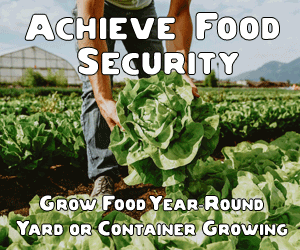Introduction:
Learning how to homestead can be a big investment in time, money and energy. If the homesteading life is calling to you read on to learn more.

Why Do People Homestead?
– To provide for their own needs and have a sustainable lifestyle
– To make a living off the land, in harmony with nature and natural resources
– To become self-sufficient in food production and energy
– To be able to live a healthier lifestyle off the grid
– To live off the land, become self-sufficient, and move away from a consumer-driven society
– To save money by producing their own goods, and services
Consider what your goals for homesteading are. I wanted a more self-sufficient lifestyle and more control over where my food came from. I enjoy living in a rural area but you do have to consider things like having to drive 45 minutes to go to a store or see a doctor.
Decide what kind of homesteading you want to do:
1. Urban Homesteading: Focusing on ways to live a sustainable lifestyle in an urban setting by utilizing local resources, growing food, and managing finances.
2. Suburban Homesteading: Combining the traditional country homestead lifestyle with the modern conveniences of living in the suburbs. It may include raising animals, gardening, preserving food, and generating electricity with solar energy.
3. Rural Homesteading: Going back to the basics and living a self-sufficient lifestyle on a small piece of land in the countryside, focusing on growing food, raising animals, and providing most of your own needs.

Start Small and Scale Up
Don’t try to do too much right away or you’ll become overwhelmed quickly. Start with one area (e.g. growing food) and then move on to the other areas when you’re comfortable. Try out homesteading where you are by gardening. See if you enjoy that.
1. Check with your local government to determine what type of homesteading activities are allowed in your area.
2. Find out if there are any tax benefits or incentives available for homesteading, such as reduced property taxes or land grants.
3. Make sure you understand the zoning regulations for farming animals and growing crops on your property. It’s a sad thing to be told you have to get rid of chickens you have grown fond of!
Organize Finances
1. Determine how much money you will need to start homesteading and create a budget for purchasing land, supplies, equipment, etc. Don’t bite off more than you can chew!
2. Research grants and other sources of funding that may be available to help with the cost of homesteading. You can check for these at the local, state, or federal level. Here are a few sites to check out:
- https://www.usda.gov/media/blog/2012/02/17/start2farmgov-helps-beginning-farmers-and-ranchers-get-started
- https://www.nifa.usda.gov/grants/programs/hunger-food-security-programs/community-food-projects-competitive-grant-program-cfpcgp
- https://www.nifa.usda.gov/grants/funding-opportunities/specialty-crop-research-initiative
I’m sure there are more out there to be found.
3. Consider getting a loan or line of credit to cover the upfront costs. Be careful with this one. Debt can be crippling. It is probably better to save for what you need.
4. Develop a plan for managing your finances once you start homesteading to ensure that you can sustain it in the long-term. Many people start with something simple like growing a garden while continuing to work their regular jobs. They may add backyard chickens or rabbits if that’s allowed. Keep in mind any animals you add require ongoing care and be prepared for that work and expense.
5. If you are in an Urban area see if you can get a community garden started. There might be grants for this and the city might donate land. You can also use grow bags on your balcony. Many ways to incorporate homesteading into your life are possible in the urban environment. A wonderful thing to grow in any homestead setting is herbs. They are very expensive fresh, but taste oh so good!
Purchase Supplies and Equipment:
1. Choose the necessary tools, equipment, and supplies based on your intended homesteading activities. This will depend on what type of homesteading you decide to do. You don’t need much to fill a few grow bags with soil and plant herbs or tomatoes.
Special Issues for Rural Homesteading
If you do decide to make a go of rural homesteading you will need to carefully research where you buy your land. Does it have water? Does it have road access? Does it have dirt? Really! My property is mostly bedrock with shallow soiled woodlands. That’s why I am doing raised beds. I knew this when I bought it and was prepared for the expense and labor. Be sure that your land is suitable for what you want to do with it.
After acquiring land, you will need to develop the necessary infrastructure for your homestead. This could include installing fencing, building structures such as a home or barn, laying out irrigation systems, and constructing roads. If you buy raw land this is expensive. We had road access, though it’s steep and bumpy, but we had to dig a well, build a house, get outbuildings and still have not fenced. Talk about expensive!
Now that you have developed the necessary infrastructure for your homestead, it’s time to start growing crops and raising animals in order to produce food. You can start by growing vegetables, herbs, and fruits as well as raising animals such as chickens, rabbits, or goats. You don’t need a lot of land to do any of these if your goal is to provide better food for your family. Most of it can be done in a suburban setting just fine.
If your goal is to make a living homesteading, research what niche crops might be lucrative. A few that come to mind are mushrooms, microgreens, and herbs.
Once you have planted your crops and raised your animals, it is important to manage the resources on your homestead in order to ensure that everything runs smoothly. This includes managing water usage, pest control, maintaining soil health, and composting. For an article on rainwater harvesting check my article here.
Finally, it’s important to stay connected with other homesteaders so that you can learn from each other and share tips and tricks. You can join local homesteading groups or connect with online communities of homesteaders to learn from their experiences.
Homesteading is a rewarding experience that can produce many benefits for you and your family, but it does require dedication and hard work in order to get the most out of it. If you are willing to put in the effort, then you can create a lifestyle that is both sustainable and enjoyable. Good luck!
Happy Homesteading! 🙂

